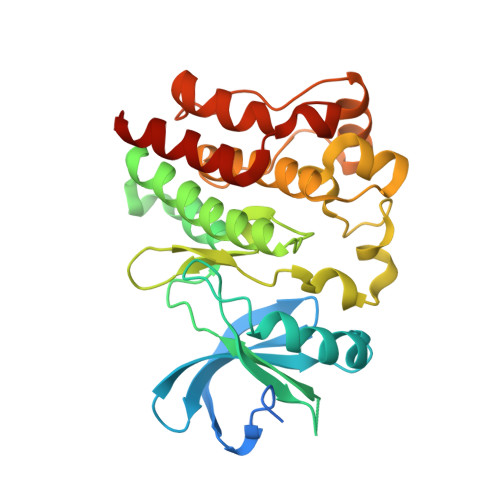Discovery of BIIB068: A Selective, Potent, Reversible Bruton's Tyrosine Kinase Inhibitor as an Orally Efficacious Agent for Autoimmune Diseases.
Ma, B., Bohnert, T., Otipoby, K.L., Tien, E., Arefayene, M., Bai, J., Bajrami, B., Bame, E., Chan, T.R., Humora, M., MacPhee, J.M., Marcotte, D., Mehta, D., Metrick, C.M., Moniz, G., Polack, E., Poreci, U., Prefontaine, A., Sheikh, S., Schroeder, P., Smirnakis, K., Zhang, L., Zheng, F., Hopkins, B.T.(2020) J Med Chem 63: 12526-12541
- PubMed: 32696648
- DOI: https://doi.org/10.1021/acs.jmedchem.0c00702
- Primary Citation of Related Structures:
6VXQ, 6W06, 6W07 - PubMed Abstract:
Autoreactive B cell-derived antibodies form immune complexes that likely play a pathogenic role in autoimmune diseases. In systemic lupus erythematosus (SLE), these antibodies bind Fc receptors on myeloid cells and induce proinflammatory cytokine production by monocytes and NETosis by neutrophils. Bruton's tyrosine kinase (BTK) is a non-receptor tyrosine kinase that signals downstream of Fc receptors and plays a transduction role in antibody expression following B cell activation. Given the roles of BTK in both the production and sensing of autoreactive antibodies, inhibitors of BTK kinase activity may provide therapeutic value to patients suffering from autoantibody-driven immune disorders. Starting from an in-house proprietary screening hit followed by structure-based rational design, we have identified a potent, reversible BTK inhibitor, BIIB068 ( 1 ), which demonstrated good kinome selectivity with good overall drug-like properties for oral dosing, was well tolerated across preclinical species at pharmacologically relevant doses with good ADME properties, and achieved >90% inhibition of BTK phosphorylation (pBTK) in humans.
- Research & Development, Biogen, 225 Binney Street, Cambridge, Massachusetts 02142, United States.
Organizational Affiliation:

















